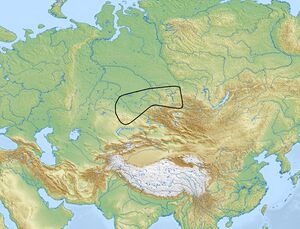ثقافة قرة سوق
 قدر من قرة سوق، القرون 12-10 ق.م. | |
 | |
| النطاق الجغرافي | South Central Siberia |
|---|---|
| الفترة | Bronze Age |
| التواريخ | ca. 1500–800 BC |
| سبقها | Afanasievo culture, Okunev culture, Andronovo culture |
| تلاها | Tagar culture, Tashtyk culture, Irmen culture |
| العصر البرونزي |
|---|
| ↑ العصر الحجري الحديث |
|
الشرق الأدنى (3300-1200 ق.م.) شبه القارة الهندية (3000-1200 ق.م.) اوروبا (3000-600 ق.م.)
الصين (3000-700 ق.م.) كوريا (1000-300 ق.م.) |
| ↓العصر الحديدي |
The Karasuk culture (روسية: Карасукская культура, romanized: Karasukskaya kul'tura) describes a group of late Bronze Age societies who ranged from the Aral Sea to the upper Yenisei in the east and south to the Altai Mountains and the Tian Shan in ca. 1500–800 BC.[1]
Overview
The distribution of the Karasuk culture covers the eastern parts of the Andronovo culture, which it appears to replace.[1][2] The remains of settlements are minimal, and entirely of the mortuary variety.[1] At least 2000 burials are known.[1] The Karasuk period persisted down to c. 700 BC. From c. 700 to c. 200 BC, culture developed along similar lines. Vital trade contact is traced from northern China and the Baikal region to the Black Sea and the Urals, influencing the uniformity of the culture.[3] The Karasuk was succeeded by the Tagar culture.[2][4]
The economy was mixed agriculture and stockbreeding.[1] Its culture appears to have been more mobile than the Andronovo.[1] The Karasuk were farmers who practiced metallurgy on a large scale.[2] Arsenical bronze artefacts are present.[1] Their settlements were of pit houses and they buried their dead in stone cists covered by kurgans and surrounded by square stone enclosures.[1] Industrially, they were skilled metalworkers, the diagnostic artifacts of the culture being a bronze knife with curving profiles and a decorated handle and horse bridles.[1] The pottery has been compared to that discovered in Inner Mongolia and the interior of China, with burials bronze knives similar to those from northeastern China.[5] Their realistic animal art probably contributed to the development of the Scytho-Siberian animal art style (Scythian art).[2]
The origins of the Karasuk culture are complex, but it is generally accepted that its origins lie both with the Andronovo culture and local cultures of the Yenisei.[1] The ethnic identity of the Karasuk is problematic, as the Andronovo culture has been associated with the Indo-Iranians while the local cultures have been considered as unconnected to the steppe.[1] Nevertheless, a specifically Proto-Iranian identity has been proposed for the Karasuk culture.[1] The Karasuk tribes have been described by archaeologists as exhibiting pronounced Caucasoid/Europoid features.[2] George van Driem has suggested a connection with the Yeniseian and Burushaski people, proposing a Karasuk languages group.[6]
Keyser rt al. (2009) published a genetic study of ancient Siberian cultures, the Andronovo culture, the Karasuk culture, the Tagar culture and the Tashtyk culture.[2] They surveyed four individuals of the Karasuk culture of four different sites from 1400 BC to 800 BC. Two of these possessed the Western Eurasian mtDNA U5a1 and U4 lineages. Two other ones exhibited the Y-chromosome haplogroup R1a1, which is thought to mark the eastward migration of the early Indo-Europeans.[2] The individuals surveyed were all determined to be Europoid and light-eyed.[2]
References
Citations
- ^ أ ب ت ث ج ح خ د ذ ر ز س Mallory 1997, pp. 325–326
- ^ أ ب ت ث ج ح خ د Keyser, Christine; Bouakaze, Caroline; Crubézy, Eric; Nikolaev, Valery G.; Montagnon, Daniel; Reis, Tatiana; Ludes, Bertrand (May 16, 2009). "Ancient DNA provides new insights into the history of south Siberian Kurgan people". Human Genetics. 126 (3): 395–410. doi:10.1007/s00439-009-0683-0. PMID 19449030.
- ^ "Stone Age: European cultures". Encyclopædia Britannica Online. Encyclopædia Britannica. Retrieved February 15, 2015.
- ^ "Central Asian arts: Neolithic and Metal Age cultures". Encyclopædia Britannica Online. Encyclopædia Britannica. Retrieved February 15, 2015.
- ^ Geraldine Reinhardt: Bronze Age in Eurasia, Lecture 13 delivered 5 August 1991[dead link].
- ^ van Driem, George (2007). "Endangered Languages of South Asia". In Brenzinger, Matthias (ed.). Language Diversity Endangered. Berlin and New York: Mouton de Gruyter. p. 304.
Sources
- Mallory, J. P. (1997). Encyclopedia of Indo-European Culture. Taylor & Francis. ISBN 978-1884964985. Retrieved February 15, 2015.
- Articles with dead external links from December 2017
- Short description is different from Wikidata
- Pages using infobox archaeological culture with unknown parameters
- Articles containing روسية-language text
- Pages using Lang-xx templates
- ثقافات العصر البرونزي في آسيا
- Archaeological cultures of Siberia
- Archaeological cultures of Central Asia
- Iranian archaeological cultures
- Archaeological cultures in Kazakhstan
- Archaeological cultures in Russia